Homeostasis and systematic ageing as non-equilibrium phase transitions in computational multicellular organizations

Abstract
Being a fatal threat to life, the breakdown of homeostasis in tissues is believed to involve multiscale factors ranging from the accumulation of genetic damages to the deregulation of metabolic processes. Here, we present a prototypical multicellular homeostasis model in the form of a two-dimensional stochastic cellular automaton with three cellular states, cell division, cell death and cell cycle arrest, of which the state-updating rules are based on fundamental cell biology. Despite the simplicity, this model illustrates how multicellular organizations can develop into diverse homeostatic patterns with distinct morphologies, turnover rates and lifespans without considering genetic, metabolic or other exogenous variations. Through mean-field analysis and Monte–Carlo simulations, those homeostatic states are found to be classified into extinctive, proliferative and degenerative phases, whereas healthy multicellular organizations evolve from proliferative to degenerative phases over a long time, undergoing a systematic ageing akin to a transition into an absorbing state in non-equilibrium physical systems. It is suggested that the collapse of homeostasis at the multicellular level may originate from the fundamental nature of cell biology regarding the physics of some non-equilibrium processes instead of subcellular details.